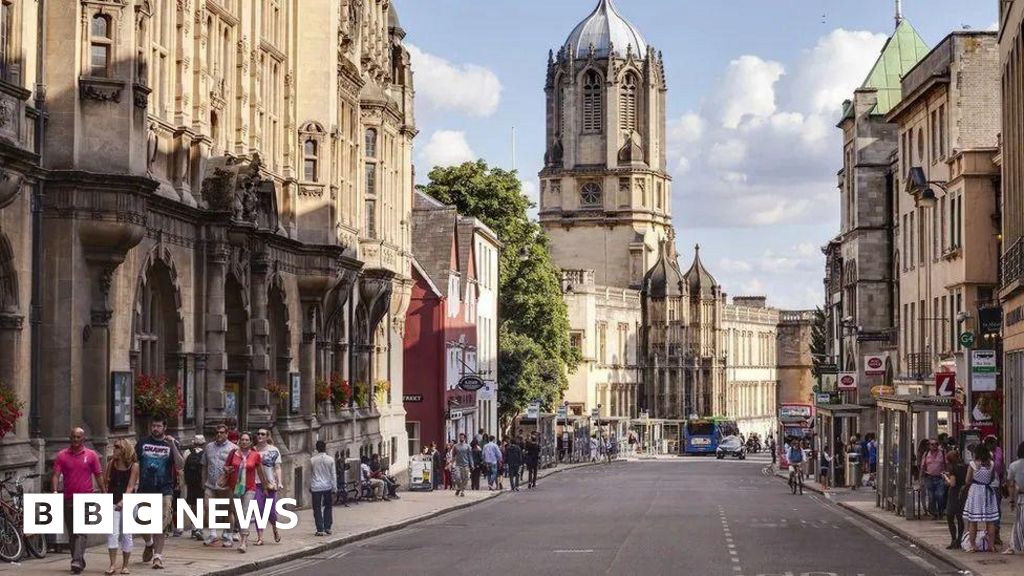Oxford air pollution falling faster than UK average, council says

The levels of air pollution in a city have gone down at a greater rate over the past year than the national average.
The levels of Nitrogen Dioxide (NO2) – which is formed when fossil fuels are burnt – were measured at 128 different sites across the city as part of the annual Oxford City Council air quality report.
Air pollution levels in Oxford have decreased by 14% on average, compared with a 9% average reduction across the UK, according to the city council study.
It comes two years after a Zero Emission Zone (ZEZ) pilot scheme began on nine streets in the city centre.
The report found that Oxford was below the UK’s legal limit for NO2 in all areas of “relevant exposure” within the city.
Those areas include places where the public is likely to regularly spend time, such as residential areas and the city centre.
That included every location both inside and around the city’s Low Traffic Neighbourhoods and ZEZ pilot, according to the report.
Across the whole city, two of the 128 sites measured were below the UK’s legal target for air pollution.
Tina Mould, who is Oxford City Council’s environmental sustainability lead, said: “It is great to see that Oxford is continuing to see reductions in air pollution, and that so many locations are now compliant not only with the legal target, but the council’s local target.
“However, there is ultimately no safe level of air pollution and further reductions are still needed to help protect everyone who lives, works, and visits Oxford.”
The World Health Organisation (WHO) estimates that about 7 million deaths each year are linked to air pollution.
The final rollout of Oxford’s ZEZ – expected to take place during the 2026/2027 financial year – will involve most of the city centre.
The project, which involves charging non-electric vehicles’ drivers with the aim of improving air quality, has come in for criticism from opposition groups.
Independent councillor for Cowley Sajjad Malik labelled the scheme a “congestion charge” that would be “detrimental to businesses.”
Mr Malik described the scheme’s ethos as being “as long as you can pay us you can drive any vehicle”.
He also claimed there was hypocrisy in the city not having buses that would be fully compliant.
The current ZEZ scheme is being delivered by Oxfordshire County Council, though the city council previously oversaw it.
City bus fleets are owned by private companies but the county council deals with the contracts.
In response, Judy Roberts, cabinet member for development strategy at Oxfordshire County Council, said: “The zero emission zone in Oxford is all about making our city cleaner and healthier.”
“The proposals are draft at this stage and will be informed by our conversations with businesses and residents especially, as well as traffic and air quality modelling and a business impact assessment.”
The zone is supported by the Liberal Democrats and Green Party coalition-run county council, as well as the Labour-run city council.
It was Labour that initially developed the scheme, although the idea was first proposed in 2015 by the then Conservative-run county council.
The Tories now oppose the scheme though, questioning its impact on businesses.
Related
Youth football teams hold minute’s silence for 10-year-old Poppy Atkinson
Youth football teams and grassroots clubs across the country have held a minute’s silence at the start of their games to commemorate a 10-year-old girl who di
Girl’s death sparks minute’s silence at football matches nationwide
10-year-old Poppy Atkinson was killed when she was struck by a car during a training session at Kendal Rugby Club in Cumbria. Clubs from Leeds to London
Liverpool fans’ Uefa claim can be heard in England, judge…
The high court, sitting in Liverpool, heard Uefa had relied upon the principle that English courts will not inquire into the legality of actions by foreign gove
Alan Shearer’s Premier League predictions including Manchester United vs Arsenal
Caption: Alan Shearer?s Premier League predictions credit: Getty / Metro After some impressive results for English sides in Europe the focus is












